Study on changes in chemical compositions and bioactive compounds in pouteria campechiana fruit during storage
Pouteria campechiana, a fruit cultivated in many provinces of the Mekong Delta, is
typically eaten fresh and has many benefits to human health. Therefore, quality control during
storage of this fruit is very important for fresh consumption and food processing. This study was
conducted to investigate the effects of postharvest maturity on the quality of the fruit stored at
room temperature, mainly on its chemical composition and bioactive compounds content. The
results showed that storage time greatly affected the amounts of carotenoids, tannin, phenolic
and flavonoids: the highest content of carotenoids, polyphenols, flavonoids were obtained at day
10th of storage while tannin content gradually declined. The greatest antioxidant activity of fruit
extracts was also obtained after 10 days storage. It was recommended that the highest nutritional
value of Pouteria campechiana can be achieved from 8 to 10 days after harvest.
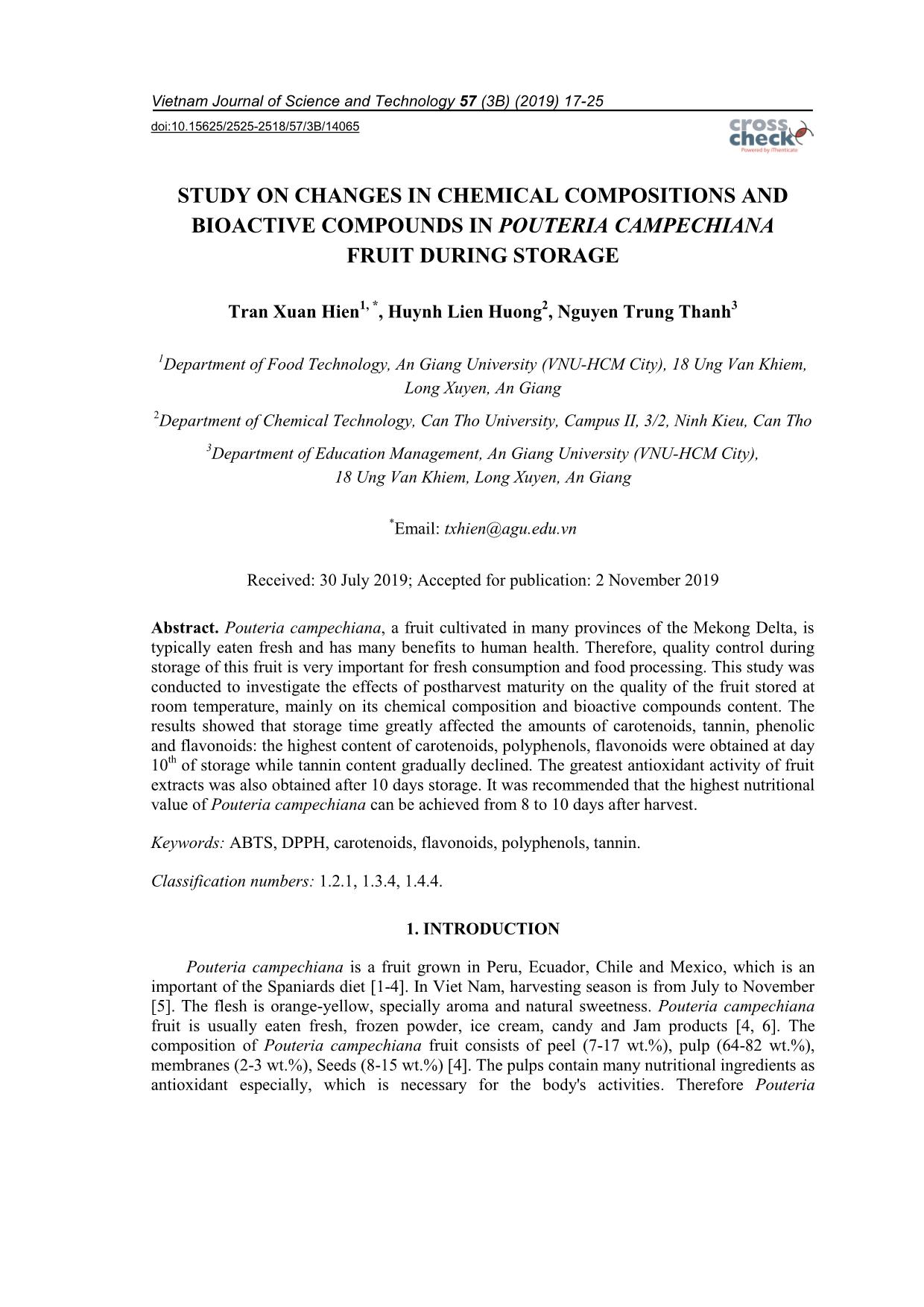
Trang 1
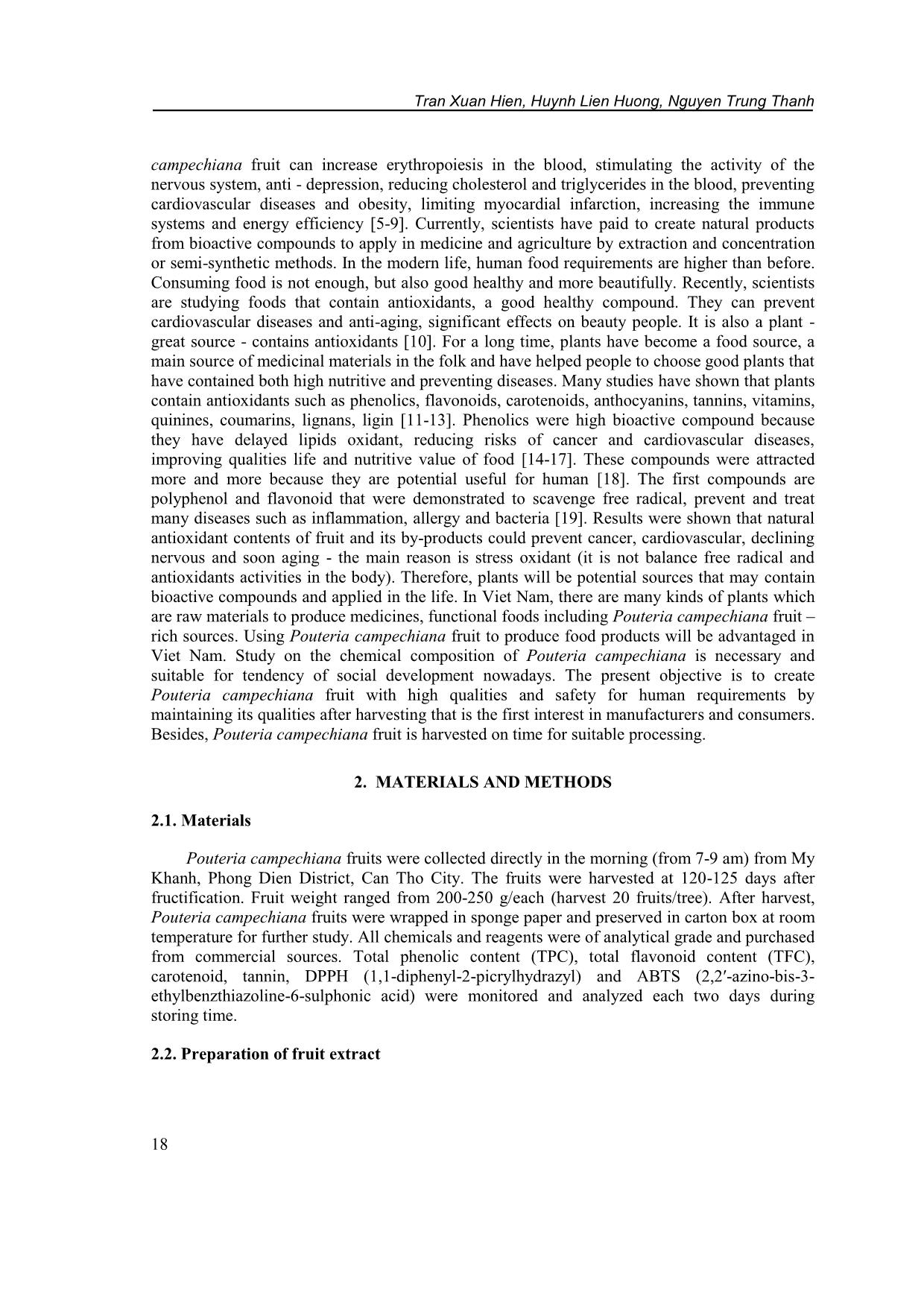
Trang 2
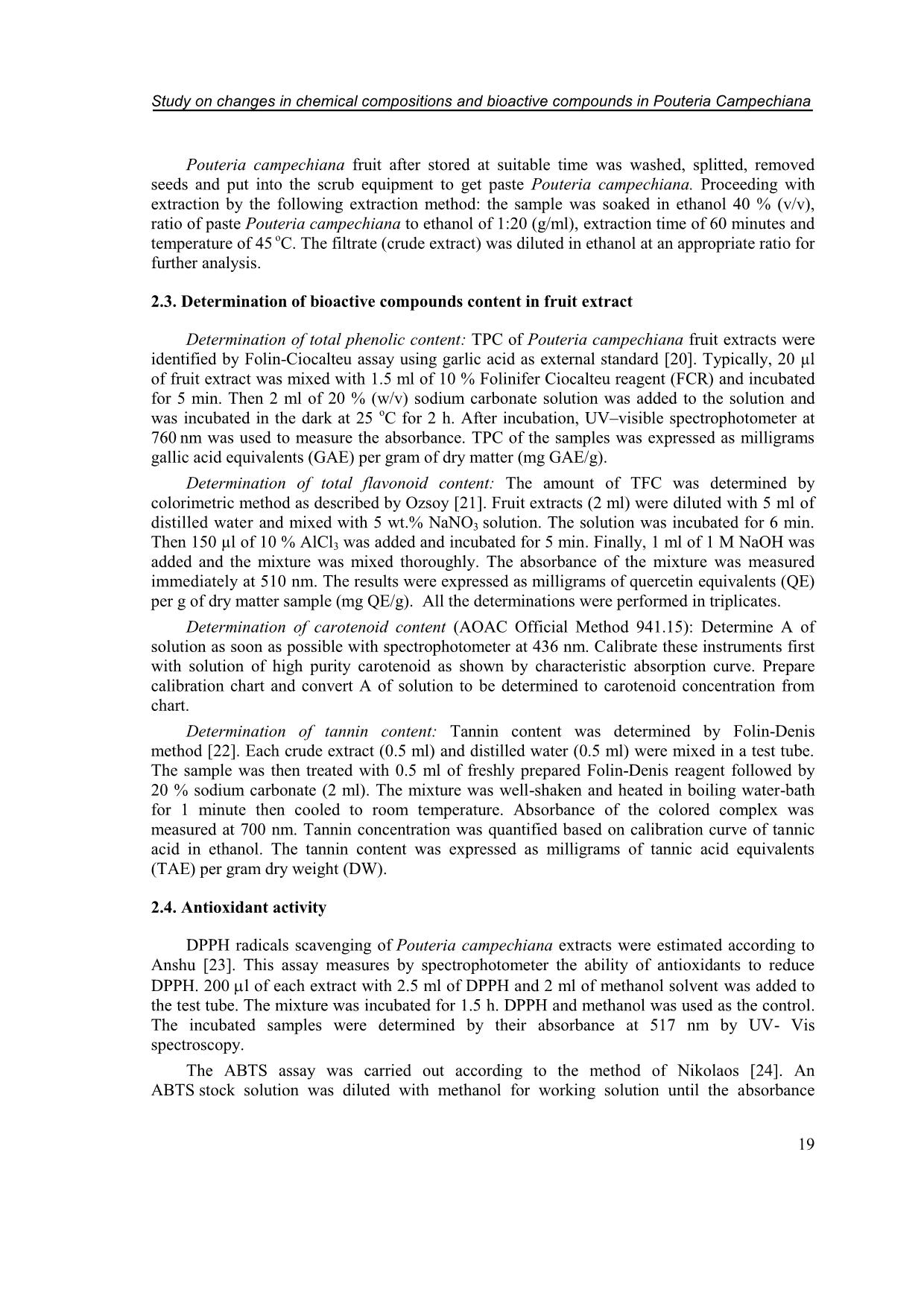
Trang 3
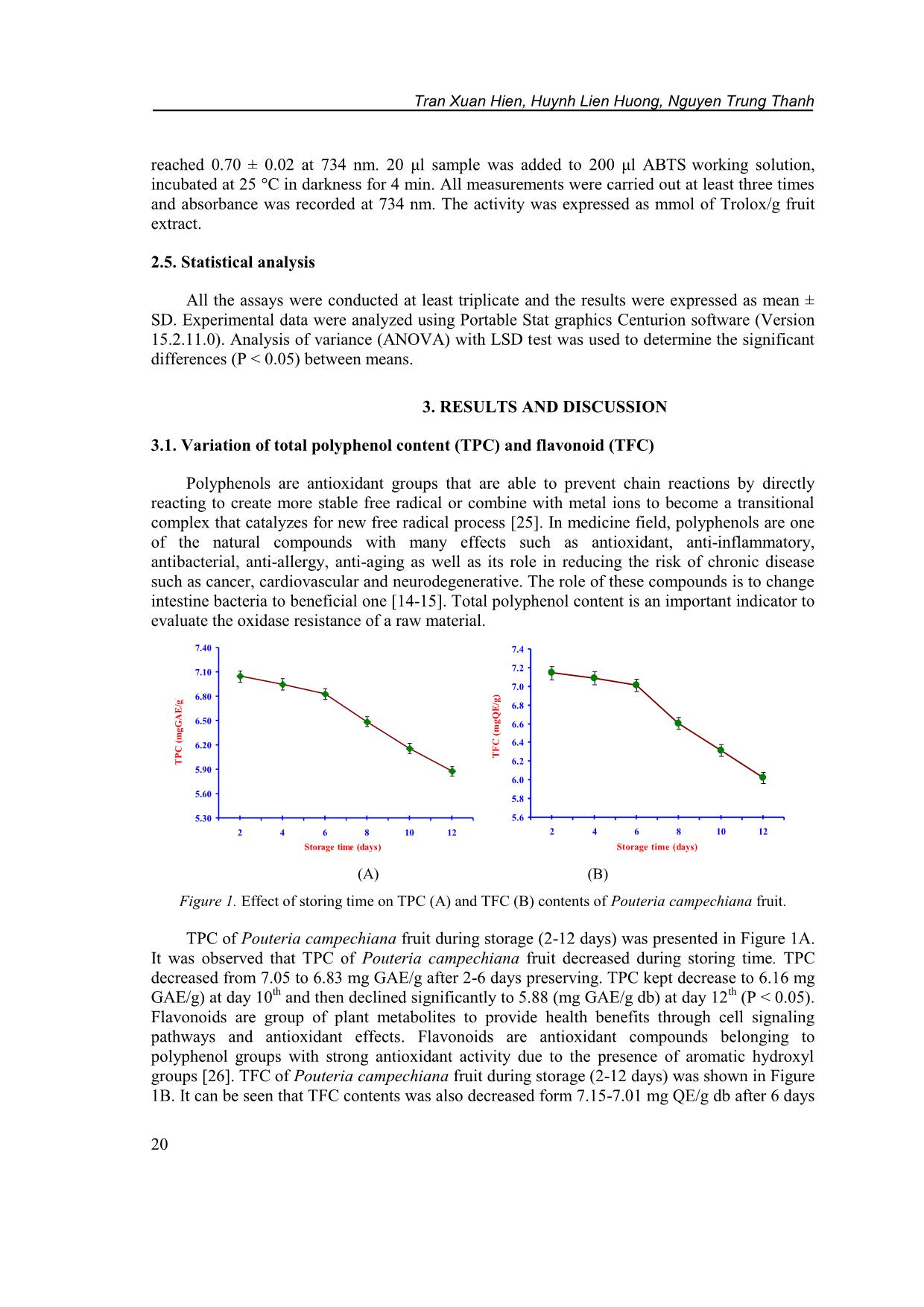
Trang 4
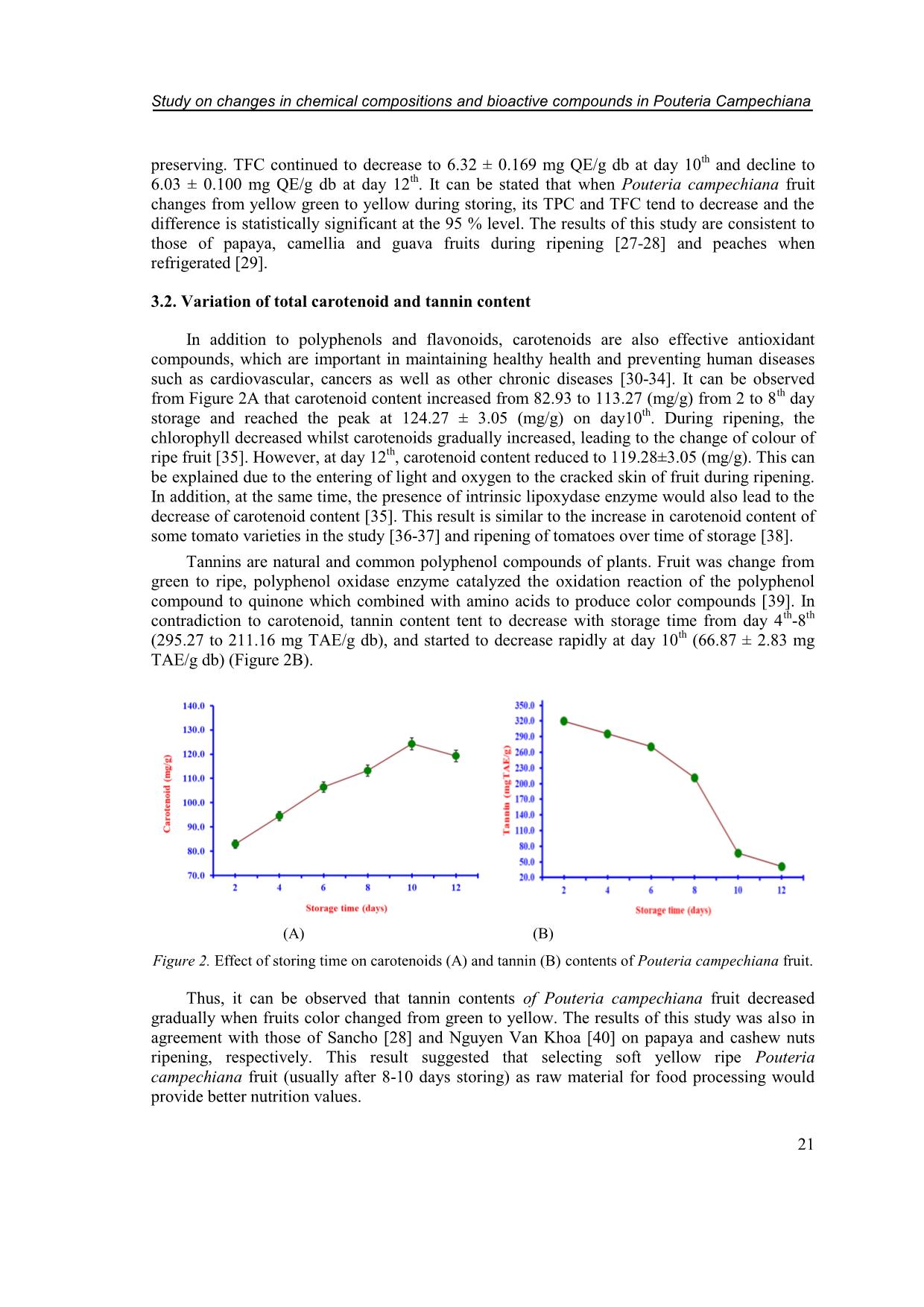
Trang 5
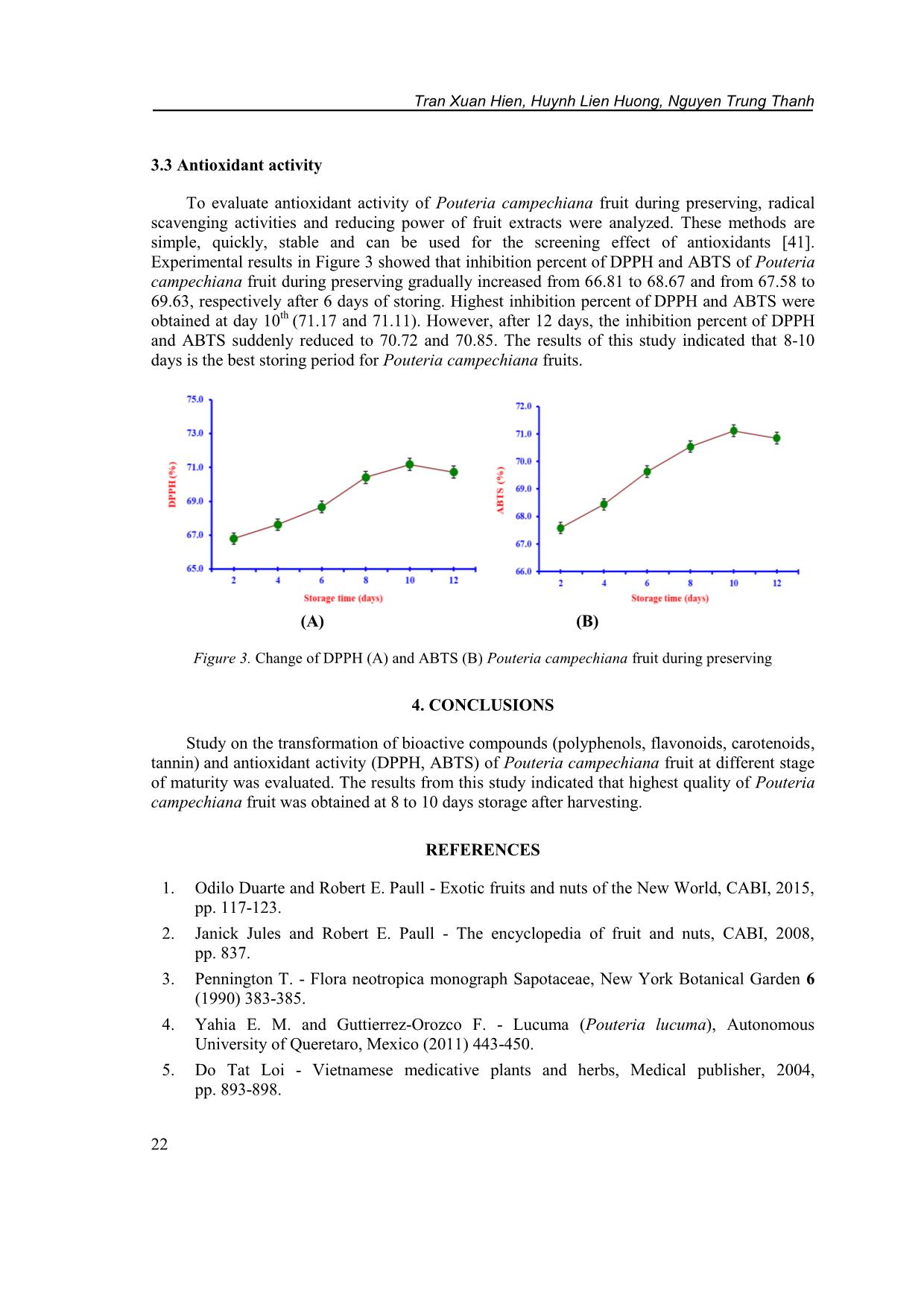
Trang 6

Trang 7
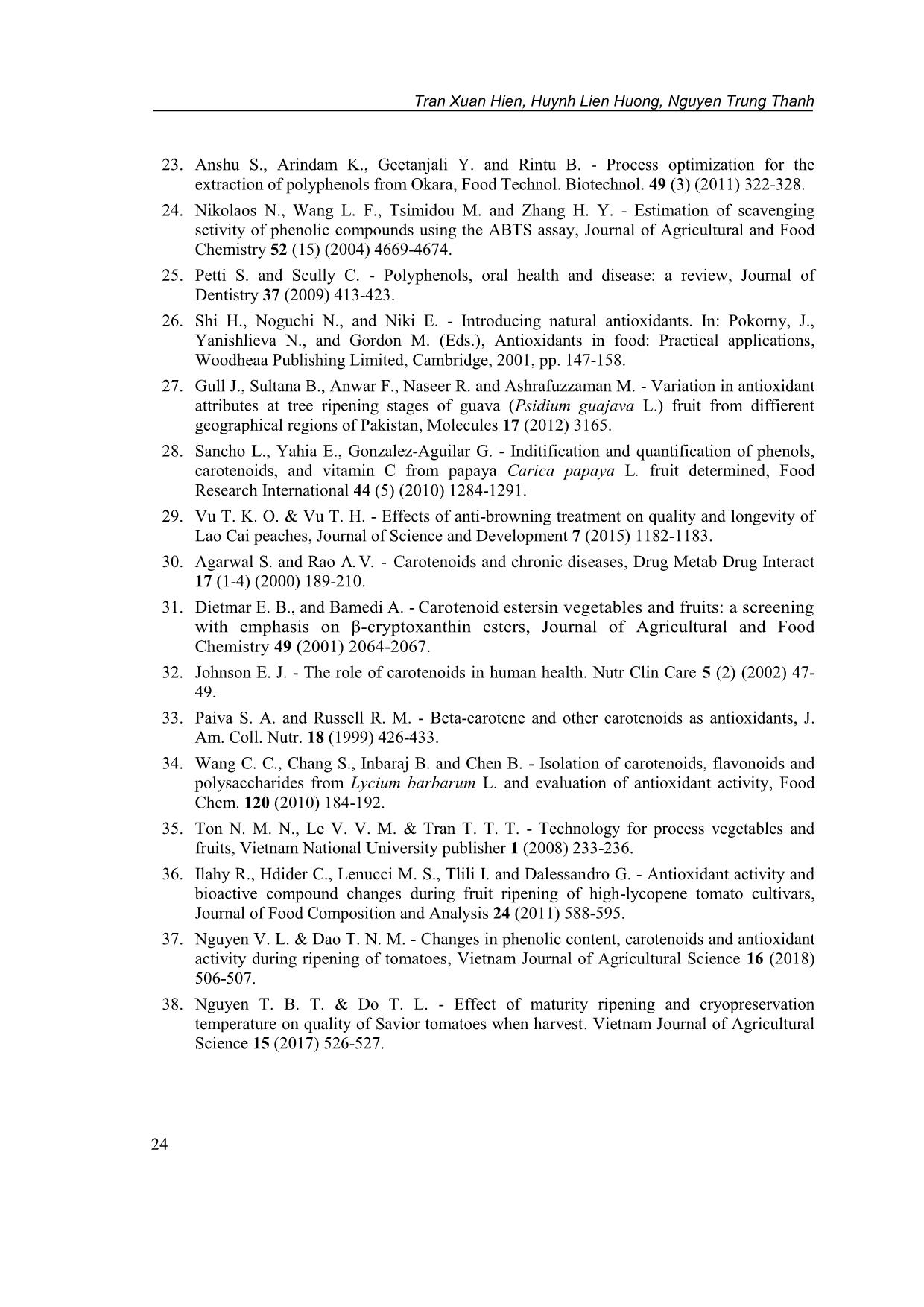
Trang 8
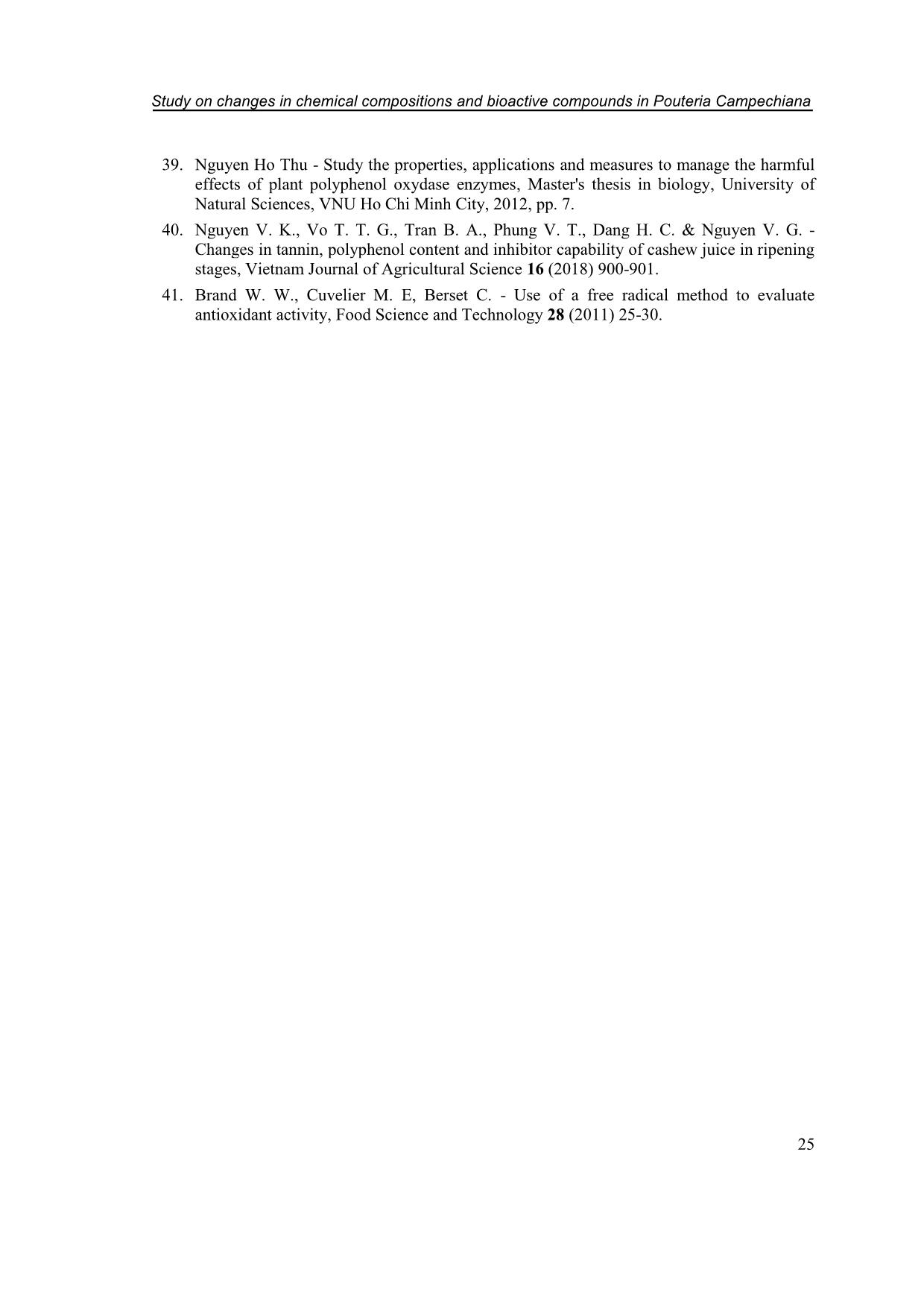
Trang 9
Tóm tắt nội dung tài liệu: Study on changes in chemical compositions and bioactive compounds in pouteria campechiana fruit during storage
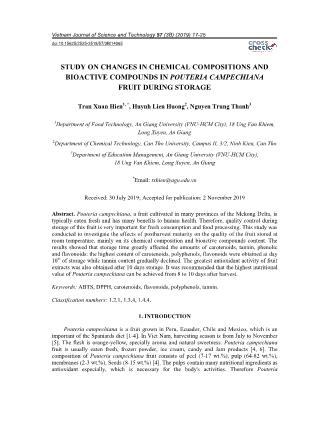
Vietnam Journal of Science and Technology 57 (3B) (2019) 17-25 doi:10.15625/2525-2518/57/3B/14065 STUDY ON CHANGES IN CHEMICAL COMPOSITIONS AND BIOACTIVE COMPOUNDS IN POUTERIA CAMPECHIANA FRUIT DURING STORAGE Tran Xuan Hien 1, * , Huynh Lien Huong 2 , Nguyen Trung Thanh 3 1 Department of Food Technology, An Giang University (VNU-HCM City), 18 Ung Van Khiem, Long Xuyen, An Giang 2 Department of Chemical Technology, Can Tho University, Campus II, 3/2, Ninh Kieu, Can Tho 3 Department of Education Management, An Giang University (VNU-HCM City), 18 Ung Van Khiem, Long Xuyen, An Giang * Email: txhien@agu.edu.vn Received: 30 July 2019; Accepted for publication: 2 November 2019 Abstract. Pouteria campechiana, a fruit cultivated in many provinces of the Mekong Delta, is typically eaten fresh and has many benefits to human health. Therefore, quality control during storage of this fruit is very important for fresh consumption and food processing. This study was conducted to investigate the effects of postharvest maturity on the quality of the fruit stored at room temperature, mainly on its chemical composition and bioactive compounds content. The results showed that storage time greatly affected the amounts of carotenoids, tannin, phenolic and flavonoids: the highest content of carotenoids, polyphenols, flavonoids were obtained at day 10 th of storage while tannin content gradually declined. The greatest antioxidant activity of fruit extracts was also obtained after 10 days storage. It was recommended that the highest nutritional value of Pouteria campechiana can be achieved from 8 to 10 days after harvest. Keywords: ABTS, DPPH, carotenoids, flavonoids, polyphenols, tannin. Classification numbers: 1.2.1, 1.3.4, 1.4.4. 1. INTRODUCTION Pouteria campechiana is a fruit grown in Peru, Ecuador, Chile and Mexico, which is an important of the Spaniards diet [1-4]. In Viet Nam, harvesting season is from July to November [5]. The flesh is orange-yellow, specially aroma and natural sweetness. Pouteria campechiana fruit is usually eaten fresh, frozen powder, ice cream, candy and Jam products [4, 6]. The composition of Pouteria campechiana fruit consists of peel (7-17 wt.%), pulp (64-82 wt.%), membranes (2-3 wt.%), Seeds (8-15 wt.%) [4]. The pulps contain many nutritional ingredients as antioxidant especially, which is necessary for the body's activities. Therefore Pouteria Tran Xuan Hien, Huynh Lien Huong, Nguyen Trung Thanh 18 campechiana fruit can increase erythropoiesis in the blood, stimulating the activity of the nervous system, anti - depression, reducing cholesterol and triglycerides in the blood, preventing cardiovascular diseases and obesity, limiting myocardial infarction, increasing the immune systems and energy efficiency [5-9]. Currently, scientists have paid to create natural products from bioactive compounds to apply in medicine and agriculture by extraction and concentration or semi-synthetic methods. In the modern life, human food requirements are higher than before. Consuming food is not enough, but also good healthy and more beautifully. Recently, scientists are studying foods that contain antioxidants, a good healthy compound. They can prevent cardiovascular diseases and anti-aging, significant effects on beauty people. It is also a plant - great source - contains antioxidants [10]. For a long time, plants have become a food source, a main source of medicinal materials in the folk and have helped people to choose good plants that have contained both high nutritive and preventing diseases. Many studies have shown that plants contain antioxidants such as phenolics, flavonoids, carotenoids, anthocyanins, tannins, vitamins, quinines, coumarins, lignans, ligin [11-13]. Phenolics were high bioactive compound because they have delayed lipids oxidant, reducing risks of cancer and cardiovascular diseases, improving qualities life and nutritive value of food [14-17]. These compounds were attracted more and more because they are potential useful for human [18]. The first compounds are polyphenol and flavonoid that were demonstrated to scavenge free radical, prevent and treat many diseases such as inflammation, allergy and bacteria [19]. Results were shown that natural antioxidant contents of fruit and its by-products could prevent cancer, cardiovascular, declining nervous and soon aging - the main reason is stress oxidant (it is not balance free radical and antioxidants activities in the body). Therefore, plants will be potential sources that may contain bioactive compounds and applied in the life. In Viet Nam, there are many kinds of plants which are raw materials to produce medicines, functional foods including Pouteria campechiana fruit – rich sources. Using Pouteria campechiana fruit to produce food products will be advantaged in Viet Nam. Study on the chemical composition of Pouteria campechiana is necessary and suitable for tendency of social development nowadays. The present objective is to create Pouteria campechiana fruit with high qualities and safety for human requirements by maintaining its qualities after harvesting that is the first interest in manufacturers and consumers. Besides, Pouteria campechiana fruit is harvested on time for suitable processing. 2. MATERIALS AND METHODS 2.1. Materials Pouteria campechiana fruits were collected directly in the morning (from 7-9 am) from My Khanh, Phong Dien District, Can Tho City. The fruits were harvested at 120-125 days after fructification. Fruit weight ranged from 200-250 g/each (harvest 20 fruits/tree). After harvest, Pouteria campechiana fruits were wrapped in sponge paper and preserved in carton box at room temperature for further study. All chemicals and reagents were of analytical grade and purchased from commercial sources. Total phenolic content (TPC), total flavonoid content (TFC), ... ssed as mean ± SD. Experimental data were analyzed using Portable Stat graphics Centurion software (Version 15.2.11.0). Analysis of variance (ANOVA) with LSD test was used to determine the significant differences (P < 0.05) between means. 3. RESULTS AND DISCUSSION 3.1. Variation of total polyphenol content (TPC) and flavonoid (TFC) Polyphenols are antioxidant groups that are able to prevent chain reactions by directly reacting to create more stable free radical or combine with metal ions to become a transitional complex that catalyzes for new free radical process [25]. In medicine field, polyphenols are one of the natural compounds with many effects such as antioxidant, anti-inflammatory, antibacterial, anti-allergy, anti-aging as well as its role in reducing the risk of chronic disease such as cancer, cardiovascular and neurodegenerative. The role of these compounds is to change intestine bacteria to beneficial one [14-15]. Total polyphenol content is an important indicator to evaluate the oxidase resistance of a raw material. 5.30 5.60 5.90 6.20 6.50 6.80 7.10 7.40 2 4 6 8 10 12 Storage time (days) T P C ( m g G A E /g ) 5.6 5.8 6.0 6.2 6.4 6.6 6.8 7.0 7.2 7.4 2 4 6 8 10 12 Storage time (days) T F C ( m g Q E /g ) (A) (B) Figure 1. Effect of storing time on TPC (A) and TFC (B) contents of Pouteria campechiana fruit. TPC of Pouteria campechiana fruit during storage (2-12 days) was presented in Figure 1A. It was observed that TPC of Pouteria campechiana fruit decreased during storing time. TPC decreased from 7.05 to 6.83 mg GAE/g after 2-6 days preserving. TPC kept decrease to 6.16 mg GAE/g) at day 10 th and then declined significantly to 5.88 (mg GAE/g db) at day 12 th (P < 0.05). Flavonoids are group of plant metabolites to provide health benefits through cell signaling pathways and antioxidant effects. Flavonoids are antioxidant compounds belonging to polyphenol groups with strong antioxidant activity due to the presence of aromatic hydroxyl groups [26]. TFC of Pouteria campechiana fruit during storage (2-12 days) was shown in Figure 1B. It can be seen that TFC contents was also decreased form 7.15-7.01 mg QE/g db after 6 days Study on changes in chemical compositions and bioactive compounds in Pouteria Campechiana 21 preserving. TFC continued to decrease to 6.32 ± 0.169 mg QE/g db at day 10 th and decline to 6.03 ± 0.100 mg QE/g db at day 12 th . It can be stated that when Pouteria campechiana fruit changes from yellow green to yellow during storing, its TPC and TFC tend to decrease and the difference is statistically significant at the 95 % level. The results of this study are consistent to those of papaya, camellia and guava fruits during ripening [27-28] and peaches when refrigerated [29]. 3.2. Variation of total carotenoid and tannin content In addition to polyphenols and flavonoids, carotenoids are also effective antioxidant compounds, which are important in maintaining healthy health and preventing human diseases such as cardiovascular, cancers as well as other chronic diseases [30-34]. It can be observed from Figure 2A that carotenoid content increased from 82.93 to 113.27 (mg/g) from 2 to 8 th day storage and reached the peak at 124.27 ± 3.05 (mg/g) on day10 th . During ripening, the chlorophyll decreased whilst carotenoids gradually increased, leading to the change of colour of ripe fruit [35]. However, at day 12 th , carotenoid content reduced to 119.28±3.05 (mg/g). This can be explained due to the entering of light and oxygen to the cracked skin of fruit during ripening. In addition, at the same time, the presence of intrinsic lipoxydase enzyme would also lead to the decrease of carotenoid content [35]. This result is similar to the increase in carotenoid content of some tomato varieties in the study [36-37] and ripening of tomatoes over time of storage [38]. Tannins are natural and common polyphenol compounds of plants. Fruit was change from green to ripe, polyphenol oxidase enzyme catalyzed the oxidation reaction of the polyphenol compound to quinone which combined with amino acids to produce color compounds [39]. In contradiction to carotenoid, tannin content tent to decrease with storage time from day 4 th -8 th (295.27 to 211.16 mg TAE/g db), and started to decrease rapidly at day 10 th (66.87 ± 2.83 mg TAE/g db) (Figure 2B). (A) (B) Figure 2. Effect of storing time on carotenoids (A) and tannin (B) contents of Pouteria campechiana fruit. Thus, it can be observed that tannin contents of Pouteria campechiana fruit decreased gradually when fruits color changed from green to yellow. The results of this study was also in agreement with those of Sancho [28] and Nguyen Van Khoa [40] on papaya and cashew nuts ripening, respectively. This result suggested that selecting soft yellow ripe Pouteria campechiana fruit (usually after 8-10 days storing) as raw material for food processing would provide better nutrition values. Tran Xuan Hien, Huynh Lien Huong, Nguyen Trung Thanh 22 3.3 Antioxidant activity To evaluate antioxidant activity of Pouteria campechiana fruit during preserving, radical scavenging activities and reducing power of fruit extracts were analyzed. These methods are simple, quickly, stable and can be used for the screening effect of antioxidants [41]. Experimental results in Figure 3 showed that inhibition percent of DPPH and ABTS of Pouteria campechiana fruit during preserving gradually increased from 66.81 to 68.67 and from 67.58 to 69.63, respectively after 6 days of storing. Highest inhibition percent of DPPH and ABTS were obtained at day 10 th (71.17 and 71.11). However, after 12 days, the inhibition percent of DPPH and ABTS suddenly reduced to 70.72 and 70.85. The results of this study indicated that 8-10 days is the best storing period for Pouteria campechiana fruits. (A) (B) Figure 3. Change of DPPH (A) and ABTS (B) Pouteria campechiana fruit during preserving 4. CONCLUSIONS Study on the transformation of bioactive compounds (polyphenols, flavonoids, carotenoids, tannin) and antioxidant activity (DPPH, ABTS) of Pouteria campechiana fruit at different stage of maturity was evaluated. The results from this study indicated that highest quality of Pouteria campechiana fruit was obtained at 8 to 10 days storage after harvesting. REFERENCES 1. Odilo Duarte and Robert E. Paull - Exotic fruits and nuts of the New World, CABI, 2015, pp. 117-123. 2. Janick Jules and Robert E. Paull - The encyclopedia of fruit and nuts, CABI, 2008, pp. 837. 3. Pennington T. - Flora neotropica monograph Sapotaceae, New York Botanical Garden 6 (1990) 383-385. 4. Yahia E. M. and Guttierrez-Orozco F. - Lucuma (Pouteria lucuma), Autonomous University of Queretaro, Mexico (2011) 443-450. 5. Do Tat Loi - Vietnamese medicative plants and herbs, Medical publisher, 2004, pp. 893-898. Study on changes in chemical compositions and bioactive compounds in Pouteria Campechiana 23 6. Apostolidis E., Genovese M. I., Lajolo F. M., Pinto Mda S., Ranilla L. G., and Shetty K. - Evaluation of antihyperglycemia and antihpertension potential of native peruvian fruits using in vitro models, Journal of Medicinal Food 12 (2009) 278-91. 7. Chen S. S., Datta N., Jiang Y. M., Shi J., Tomas-Barberan F. A., Singanusong Y. - Flavonoids in food and their health benefits, Plant Foods for Human Nutrition 5 (2004) 113-122. 8. Irene Dini - Flavodoid glycosides from Pourteria obovata fruit flour, Food Chemistry 124 (2011) 884-888. 9. Suranant Subhadrabandhu - Under-utilized tropical fruits of Thailand, Kasetsart University, Bangkok, Thailand, 2001, pp. 14-16. 10. Huda-Faujan N., Noriham A., Norrakiah A. S., Babji A. S. - Antioxidant activity of plants methanolic extracts containing phenolic compounds. African Journal of Biotechnology 8 (3) (2009) 484-489. 11. Amarowicz R., Peggb R. B., Rahimi-Moghaddamc P., Barl B., Weil J. A. - Free-radical scavenging capacity and antioxidant activity of selected plant species from the Canadian prairies, Food Chemistry 84 (2004) 551-562. 12. Dai J. and Mumper R. J. - Plant phenolics: extraction, analysis and their antioxidant and anticancer properties, Molecules 15 (2010) 7313-7352. 13. Handique J. G. and Baruah J. B. - Polyphenolic compounds: an overview, Reactive and Functional Polymers 52 (2002) 163-188. 14. Aguilera Y., Martin-Cabrejas M. A. and De Mejia E. G. - Phenolic compounds in fruits and beverages consumed as part of the mediterranean diet: their role in prevention of chronic diseases, Phytochemistry Reviews 15 (2016) 405-423. 15. Jin D. and Russell J. M. - Plant phenolic: Extraction, analysis and antioxidant and anticancer properties, Molecules 15 (2010) 7313-7352. 16. Kähkönen M. P., Hopia A. I., Vuorela H. J., Rauha J. P., Pihlaja K., Kujala T. S., and Heinonen M. - Antioxidant activity of plant extracts containing phenolic compounds, Journal of agricultural and food chemistry 47 (10) (1999) 3954-3962. 17. Willett C. W. - Diet and health: What should we eat? Science 264 (1994) 532-537. 18. Haminiuk C. W. I., Maciel G. M., Plata-Oviedo M. S. V. and Peralta R. M. - Phenolic compounds in fruits - an overview, International Journal of Food Science and Technology 47 (2012) 2023-2044. 19. Manach C., Augustin S., Christine M., Christian R., and Liliana J. - Polyphenols: food sources and bioavailability 1,2, American Society for Clinical Nutrition 79 (2004) 727-747. 20. Susu J., Weixi C. and Baojun X. - Food quality improvement of soy milk made from short-time germinated soybeans, Foods 2 (2013) 198-212. 21. Ozsoy N., Can A., Yanardag R. and Akev N. - Antioxidant activity of Smilax excelsa L. leaf extracts, Food Chemistry 110 (2008) 571-583. 22. Laitonjam W. S., Yumnam R., Asem S. D., Wangkheirakpam S. D. - Evaluative and comparative study of biochemical, trace elements and antioxidant activity of Phlogacanthus pubinervius and Phlocanthus jenkincii, Indian Journal of Natural Products and Resources 4 (1) (2013) 67-72. Tran Xuan Hien, Huynh Lien Huong, Nguyen Trung Thanh 24 23. Anshu S., Arindam K., Geetanjali Y. and Rintu B. - Process optimization for the extraction of polyphenols from Okara, Food Technol. Biotechnol. 49 (3) (2011) 322-328. 24. Nikolaos N., Wang L. F., Tsimidou M. and Zhang H. Y. - Estimation of scavenging sctivity of phenolic compounds using the ABTS assay, Journal of Agricultural and Food Chemistry 52 (15) (2004) 4669-4674. 25. Petti S. and Scully C. - Polyphenols, oral health and disease: a review, Journal of Dentistry 37 (2009) 413-423. 26. Shi H., Noguchi N., and Niki E. - Introducing natural antioxidants. In: Pokorny, J., Yanishlieva N., and Gordon M. (Eds.), Antioxidants in food: Practical applications, Woodheaa Publishing Limited, Cambridge, 2001, pp. 147-158. 27. Gull J., Sultana B., Anwar F., Naseer R. and Ashrafuzzaman M. - Variation in antioxidant attributes at tree ripening stages of guava (Psidium guajava L.) fruit from diffierent geographical regions of Pakistan, Molecules 17 (2012) 3165. 28. Sancho L., Yahia E., Gonzalez-Aguilar G. - Inditification and quantification of phenols, carotenoids, and vitamin C from papaya Carica papaya L. fruit determined, Food Research International 44 (5) (2010) 1284-1291. 29. Vu T. K. O. & Vu T. H. - Effects of anti-browning treatment on quality and longevity of Lao Cai peaches, Journal of Science and Development 7 (2015) 1182-1183. 30. Agarwal S. and Rao A. V. - Carotenoids and chronic diseases, Drug Metab Drug Interact 17 (1-4) (2000) 189-210. 31. Dietmar E. B., and Bamedi A. - Carotenoid estersin vegetables and fruits: a screening with emphasis on β-cryptoxanthin esters, Journal of Agricultural and Food Chemistry 49 (2001) 2064-2067. 32. Johnson E. J. - The role of carotenoids in human health. Nutr Clin Care 5 (2) (2002) 47- 49. 33. Paiva S. A. and Russell R. M. - Beta-carotene and other carotenoids as antioxidants, J. Am. Coll. Nutr. 18 (1999) 426-433. 34. Wang C. C., Chang S., Inbaraj B. and Chen B. - Isolation of carotenoids, flavonoids and polysaccharides from Lycium barbarum L. and evaluation of antioxidant activity, Food Chem. 120 (2010) 184-192. 35. Ton N. M. N., Le V. V. M. & Tran T. T. T. - Technology for process vegetables and fruits, Vietnam National University publisher 1 (2008) 233-236. 36. Ilahy R., Hdider C., Lenucci M. S., Tlili I. and Dalessandro G. - Antioxidant activity and bioactive compound changes during fruit ripening of high-lycopene tomato cultivars, Journal of Food Composition and Analysis 24 (2011) 588-595. 37. Nguyen V. L. & Dao T. N. M. - Changes in phenolic content, carotenoids and antioxidant activity during ripening of tomatoes, Vietnam Journal of Agricultural Science 16 (2018) 506-507. 38. Nguyen T. B. T. & Do T. L. - Effect of maturity ripening and cryopreservation temperature on quality of Savior tomatoes when harvest. Vietnam Journal of Agricultural Science 15 (2017) 526-527. Study on changes in chemical compositions and bioactive compounds in Pouteria Campechiana 25 39. Nguyen Ho Thu - Study the properties, applications and measures to manage the harmful effects of plant polyphenol oxydase enzymes, Master's thesis in biology, University of Natural Sciences, VNU Ho Chi Minh City, 2012, pp. 7. 40. Nguyen V. K., Vo T. T. G., Tran B. A., Phung V. T., Dang H. C. & Nguyen V. G. - Changes in tannin, polyphenol content and inhibitor capability of cashew juice in ripening stages, Vietnam Journal of Agricultural Science 16 (2018) 900-901. 41. Brand W. W., Cuvelier M. E, Berset C. - Use of a free radical method to evaluate antioxidant activity, Food Science and Technology 28 (2011) 25-30.
File đính kèm:
 study_on_changes_in_chemical_compositions_and_bioactive_comp.pdf
study_on_changes_in_chemical_compositions_and_bioactive_comp.pdf

